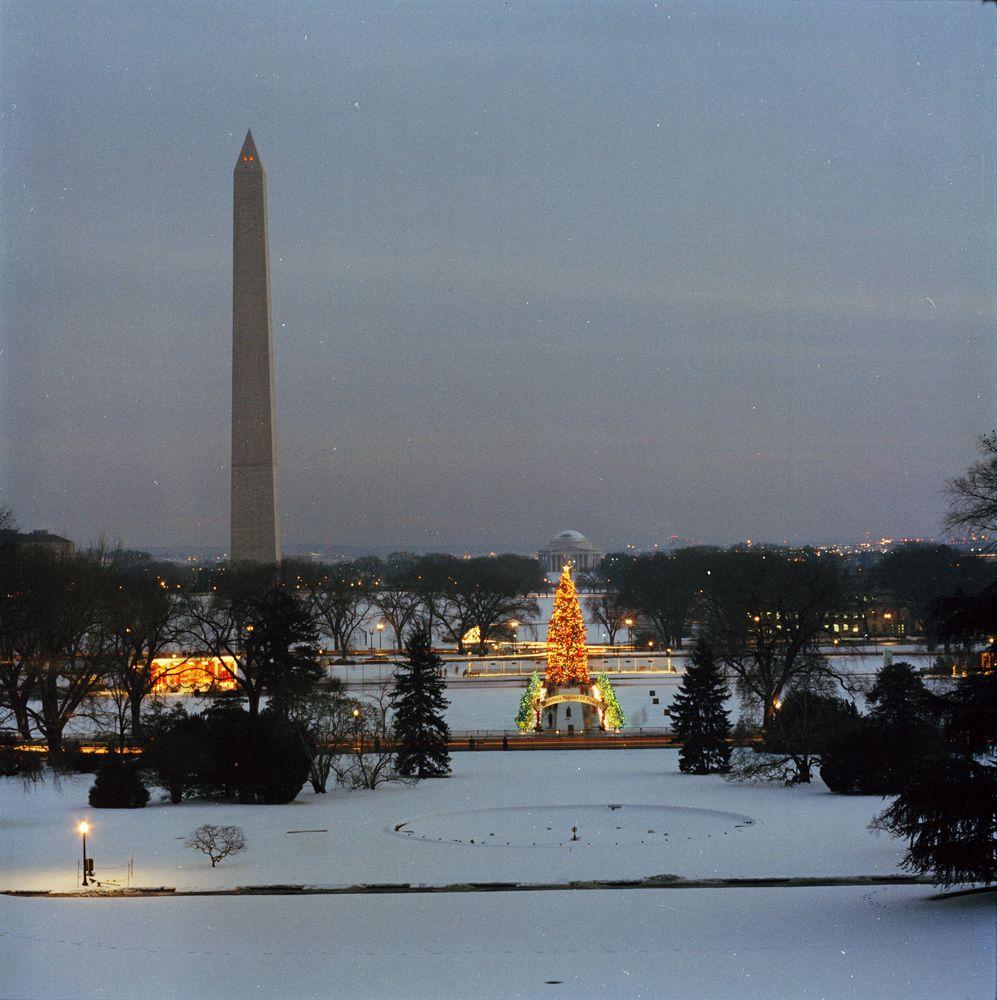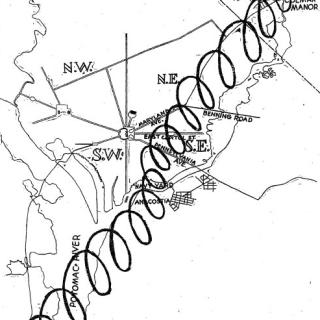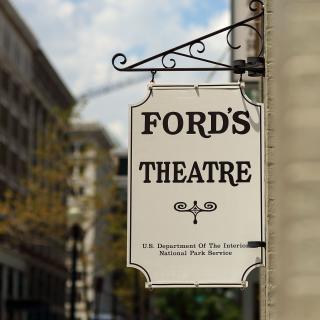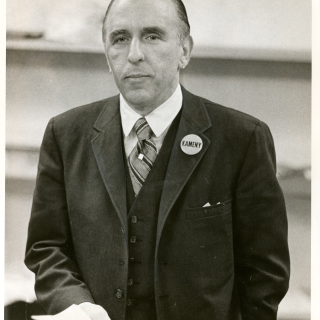The "White Christmas" of 1962
If popular culture is to be believed, then snow is a must during the holidays. Somehow, December feels cozier when the air is cold, we’re all dressed in festive sweaters, and there’s a blanket of fresh snow covering the ground. Those who celebrate Christmas, especially, are encouraged to dream of a “white Christmas.” But if a white Christmas is what you want, D.C. might not be the best place for you.
Data shows that the Washington area has only had a handful of snowy holidays—nineteen, to be exact—since record keeping began in 1884.[1] On average, the National Weather Service gives Washington a 15% chance at a white Christmas every year—in other words, every seven years, if we’re lucky.[2] The last Christmas Day that featured any kind of snow was in 2009, when the leftovers of a record-setting snowstorm (popularly named “Snowmageddon”) were still on the ground. In 2002, Washingtonians saw their most recent Christmas snowfall: a rainy morning gave way to a brief snow shower at midday. It didn’t even stick, leaving just 0.2 tenths of an inch. Lately, we’ve tended to see more heat waves than blizzards.
But if your definition of a “white Christmas” is a bit stricter, the number dwindles considerably. We’ve seen accumulative snow—that is, actually measurable snow that fell on December 25—just ten times in recorded history.[3] The most recent Christmas snowstorm came in 1969, when a little over 4 inches fell throughout the day. Just seven years earlier, though, D.C. experienced its snowiest holiday season. A record-setting 5 inches fell on December 25, 1962—to date, it’s still the most snowfall recorded on Christmas Day.[4]
December 1962 was cold and icy, but the Washington Post weather team didn’t think that snow would greatly impact the holiday season. Perhaps just as cynical as we are today, a staff writer commented that “the Weather Bureau is against it on statistical grounds.”[5] They were proven wrong a few days later. A surprise snowstorm rolled through late on Friday, December 21—the beginning of a long holiday weekend. About 4 inches of snow fell as Washington’s Jewish communities began the first night of Hannukah.[6]
It didn’t stop the holiday rush, though. If anything, the snow caused greater pandemonium than usual. The American Automobile Association still expected 250,000 area residents to set out for the long weekend, even though they would be driving in heavy snow.[7] Meanwhile, public transportation prepared for an “exodus” of travelers in the days following, as people watched the weather and planned their travel around the snow.[8] The Post also lamented that shoppers had a more difficult time completing their last-minute errands. “By midday, the streets were virtually impassable because of the traffic as shoppers, kept home by Friday’s snow, descended on the stores in near-record numbers.”[9]
Christmas Eve was a sunny day, but the Weather Bureau (later the National Weather Service) confirmed the forecast that Washingtonians—depending on their plans and preferences—either celebrated or bemoaned: a snowstorm, to produce 5-8 inches, was expected overnight.[10] One Post staff writer contemplated the historic relevance of this occasion, reminding readers that it was the first Christmas snow since 1908—when “about 5 ½ inches of snow then carpeted the Washington area, and crooner Bing Crosby, who was to popularize the dream of a white Christmas, was only four years old.”[11] Others remarked upon the overwhelming amount of shoppers who took advantage of the calm before the storm. One shopper complained that “trying to navigate across the main aisle at Woodward and Lothrop’s was a little like trying to cross a freeway at rush hour.”[12] Everyone tried to finish their preparations before nightfall, when the clouds started to roll in. According to Weather Bureau measurements taken at National Airport, 1.7 inches of snow fell on December 24.[13] Christian worshipers attended midnight services in idyllic holiday conditions.
“Not since the Weather Bureau began keeping statistics…has the yearning for a White Christmas been fulfilled so abundantly,” the Post reported.[14] Throughout the morning of December 25, another 5.3 inches was added to the initial layer—making a total of 7 inches, a whopping amount in the eyes of native Washingtonians.[15] Since any amount of snowfall in the area can cause drama, the Post noted that “had it been an ordinary weekday, the 7-inch snowfall probably would have had a crippling effect on auto, air and bus traffic,” but the holiday made this particular snowstorm relatively quiet.[16] Most people had traveled and shopped ahead of the storm, leaving them to enjoy the snow with their families at home. Some local activities went ahead as normal: church services, community charity drives, even pageants. Since Christmas and Hanukkah coincided that year, the Jewish Welfare Board organized an “Interfaith Day” for area hospitals—more than 200 volunteers ventured into the snow to bring seasonal gifts and food to the sick and their families.[17]
Perhaps the greatest benefit of the snowy holiday came the day after. In the early hours of December 26, both the Federal and District governments announced that their employees received an extra day off.[11] By then, though, warmer temperatures had turned much of the snow into slush. The winter wonderland didn’t last very long.
When the next Christmas snowstorm hit, in 1969, it didn’t dominate the newspapers as before. The novelty of a white Christmas seems to have passed. And the holiday season of 1962 is still the snowiest we’ve ever experienced—clearly wonderful then, a catalyst for nostalgia now. Even if you prefer your December warm and sunny, a snowstorm during the holiday season stands out as a landmark event in any Washingtonian’s life. Since it’s been over fifty years since we had a big white Christmas, you might expect any future ones to look a lot like 1962. If the statistics are right, then we’re due for one.
Footnotes
- ^ Jason Samenow, “Washington, D.C. Christmas weather history,” The Washington Post, December 23, 2011.
- ^ Ibid.
- ^ Ibid.
- ^ Ibid.
- ^ “Christmas Day Snow Would Be Tenth for D.C.”, The Washington Post, December 20, 1962.
- ^ Jewish Calendar 1962, https://www.hebcal.com/hebcal/
- ^ Stephen Isaacs, “Carriers Ready for Exodus: White Christmas Here Held Likely; 250,000 to Leave City for Holiday,” The Washington Post, December 21, 1962.
- ^ Ibid.
- ^ Donald L. Hymes, “Shoppers Rush to Finish, then Wait for Snow,” The Washington Post, December 25, 1962.
- ^ Ibid.
- a, b “Christmas Day Snow Would Be Tenth for D.C.”, The Washington Post, December 20, 1962.
- ^ Kim Willenson, “Store Aisles Jammed Like Streets Outside: Sun Came Out and So Did Shoppers in Christmas Eve Shopping Spree,” The Washington Post, December 25, 1962.
- ^ “Seven Inches of Snow Falls on Area, Extra Day of Holiday is Possible: Police Held Over to Help Cope with Expected Snarls,” The Washington Post, December 26, 1962.
- ^ Ibid.
- ^ Ibid.
- ^ Ibid.
- ^ Kim Willenson, “Store Aisles Jammed Like Streets Outside: Sun Came Out and So Did Shoppers in Christmas Eve Shopping Spree,” The Washington Post, December 25, 1962.






![Sketch of the mythical fuan by Pearson Scott Foresman. [Source: Wikipedia]](/sites/default/files/styles/crop_320x320/public/2023-10/Goatman_Wikipedia_Faun_2_%28PSF%29.png?h=64a074ff&itok=C9Qh-PE1)












